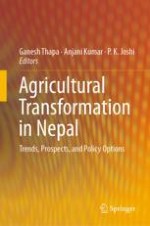2019 | OriginalPaper | Chapter
3. The Role of Agriculture in Poverty Reduction in Nepal
Authors : Ganesh Thapa, Raghav Gaiha, Katsushi Imai
Published in: Agricultural Transformation in Nepal
Publisher: Springer Singapore
Activate our intelligent search to find suitable subject content or patents.
Select sections of text to find matching patents with Artificial Intelligence. powered by
Select sections of text to find additional relevant content using AI-assisted search. powered by
